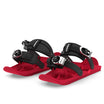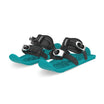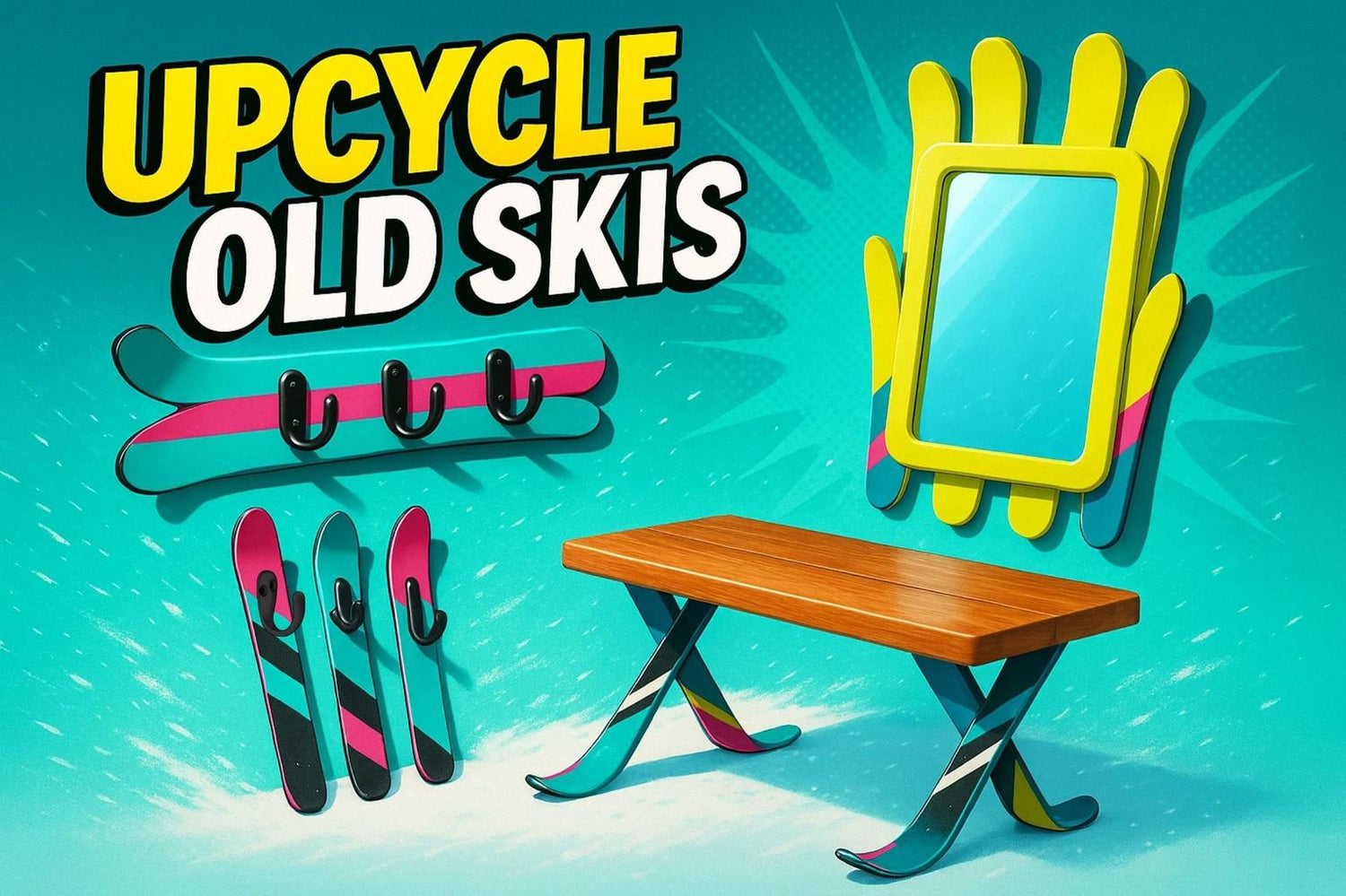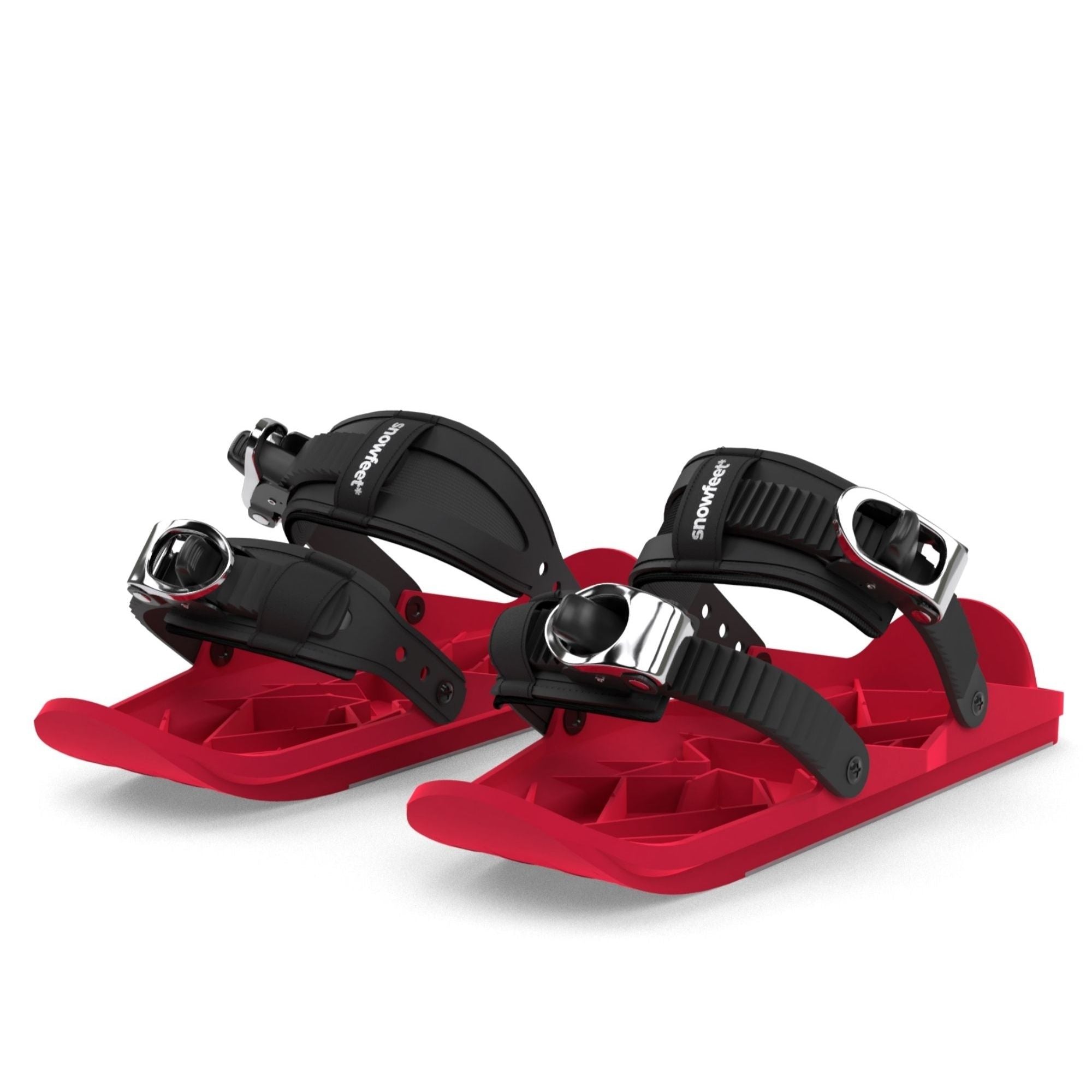Máte staré lyže? Nevyhazujte je - upcyklujte je! Lyže se těžko recyklují kvůli kombinaci materiálů jako dřevo, kov a sklolaminát, ale upcyklace je praktický způsob, jak snížit odpad a dát jim druhý život. Zde je návod, jak můžete své lyže přeměnit na funkční nebo dekorativní předměty:
- Adirondack křeslo: Použijte lyže jako opěrky rukou a zadní latě pro vytvoření křesla s lyžařskou tématikou na terasu.
- Stojan na víno: Připevněte lyže na zeď a vytvořte držák na lahve vína.
- Zahradní mříž: Podpořte popínavé rostliny spojenými lyžemi.
- Věšák na kabáty: Přeměňte lyže na nástěnné nebo volně stojící věšáky na kabáty.
- Lyžařská lampa: Vytvořte jedinečné stolní nebo stojací lampy s lyžařskými základy.
- Lavice na terasu: Postavte venkovní lavici s lyžemi jako podpěrami.
- Sněhový plot: Použijte lyže vertikálně k zamezení sněhových závějí.
- Zahradní štítky: Ořízněte špičky lyží a označte jimi rostliny ve vaší zahradě.
- Rámeček na zrcadlo: Ozdobte zrcadlo částmi lyží pro odvážnou dekoraci.

Rychlý tip:
Pokud DIY není vaše parketa, zvažte recyklační programy. Značky jako Rossignol a Atomic mají programy zpětného odběru, nebo se podívejte na místní akce jako sběr lyží v Aspenu.
Tyto nápady nejen snižují odpad, ale také pomáhají bojovat proti klimatickým změnám opětovným použitím odolných materiálů. Začněte pomalu, buďte opatrní a vytvořte něco, co budete používat!
♻Recyklované lyže🎿♻ Přetvořené lyže 🎿Nápady do šatny 😎 Nevyhazujte lyžařské vybavení!
Nástroje a materiály, které budete potřebovat
Začínáte s upcyklací lyží? Správné nástroje mohou udělat velký rozdíl. Nemusíte investovat do drahého vybavení – pár základních věcí a trochu přípravy vás dostane daleko.
Vaše nezbytné nástroje zahrnují kotoučovou pilu, pokosovou pilu nebo pevnou ruční pilu na řezání lyžařských materiálů. Dále vrtačku s různými vrtáky, metr, tužky, brusný papír (různé zrnitosti), dřevěné šrouby, dřevěné lepidlo a svorky. Nezapomeňte na ochranné pomůcky jako rukavice a ochranné brýle – to je při práci s těmito materiály nezbytné.
Pro specifické projekty můžete potřebovat doplňky. Například Jordan Berde, zakladatelka Upcycled Ski, udržuje náklady nízké použitím řezáků trubek za 15 $ a získáváním dřevěných disků z Facebook Marketplace pro výrobu zvonkohry. Spojuje je kevlarovým provázkem pro odolnost. Naopak Ryan Maclay, umělecký výrobce, staví lyžařské stromy pomocí přípravku a přesných nástrojů, svařuje lyže ocelovými pásky inspirovanými konstrukcí lanovkových věží.
Práce s lyžařskými materiály: tipy a nástroje
Lyže jsou vyrobeny z různých materiálů, takže pro každý budete potřebovat správný přístup:
- Vrstvy skelného vlákna jsou odolné a při řezání uvolňují škodlivý prach. Používejte ostré čepele a pracujte v dobře větraném prostoru.
- Kovové hrany jsou z tvrzené oceli a rychle otupí běžné pilové kotouče. Zvolte kotouče s karbidovými hroty pro hladší řezy.
Pro lepidla je G/flex epoxy revoluční. Dobře lepí na skelné vlákno, kovy i plasty a zůstává flexibilní – ideální pro lyžařské projekty. Při práci s plastovými skluznicemi lyží povrch po broušení a očištění alkoholem ošetřete plamenem. To může zvýšit pevnost přilnavosti z cca 400 psi na více než 2 300 psi u polyethylenu.
Pokud váš projekt zahrnuje malování, automobilové bezbarvé laky skvěle fungují jako pojivo komponentů. Možná bude potřeba nejprve odstranit starý nátěr pískováním. Pro kovové hrany zajistí silné spojení primery určené pro přilnavost epoxidu.
Bezpečnost především! Řezání lyží uvolňuje částice skelného vlákna a kovové třísky, které mohou být škodlivé. Vždy noste ochranné brýle, respirátor a rukavice. Pracujte v dobře větraném prostoru a po dokončení důkladně uklidťe. S vhodnými nástroji a opatřeními budete připraveni zvládnout jakýkoli projekt a zároveň chránit životní prostředí.
Kde najít cenově dostupné materiály a nástroje
Nemusíte utratit majlant, abyste mohli začít. Tady jsou skvělá místa, kde najdete nástroje a materiály:
- Home Depot je oblíbenou volbou pro širokou škálu nářadí a potřeb.
- Lowe’s často nabízí konkurenceschopné ceny na železářské zboží a spojovací materiál.
- Harbor Freight je ideální pro nástroje na rozpočet, i když kvalita může kolísat - skvělé pro nástroje, které nebudete používat často.
- Ace Hardware a True Value nabízejí osobní servis a unikátní zboží, i když sortiment se liší podle lokality.
- Do it Best, americká družstevní společnost, často nabízí konkurenceschopné ceny díky kolektivnímu nákupu.
Online tržiště jako Facebook Marketplace, Craigslist a eBay jsou poklady pro cenově dostupné materiály. Můžete zde sehnat dřevo, železářství a dokonce i specializované předměty jako dřevěné disky nebo kovové součástky za zlomek maloobchodních cen.
Nezapomeňte na půjčovny vybavení. Mnoho prodejen Home Depot a nezávislých železářství umožňuje pronájem nářadí jako jsou kotoučové pily a brusky na den nebo týden, což vám ušetří peníze za věci, které budete používat jen občas.
Pro lyžařské materiály mají specializovaní dodavatelé často to, co potřebujete, za konkurenceschopné ceny.
"Upřímně řečeno, nekoupil bych nástroj v Harbor Freight, pokud… 1. ho potřebuji použít jen jednou, A 2. nevadí mi vrátit se do Harbor Freight a koupit náhradu za ten, který jsem koupil k dosažení bodu 1. Prosím… udělejte si laskavost. Vyhněte se nástrojům nízké kvality. Dlouhodobě tím neušetříte peníze a je mnohem těžší odvést kvalitní práci, když pracujete s mizernými nástroji. Věřte mi." - Joseph Conlon Baxter
Klíčem je najít správnou rovnováhu mezi cenou a kvalitou. Investujte do spolehlivých měřicích nástrojů a bezpečnostního vybavení, ale u nástrojů, které budete používat jen zřídka, je v pořádku zvolit levnější variantu. Jakmile máte vše připraveno, můžete staré lyže proměnit v něco kreativního a udržitelného.
9 způsobů, jak upcyklovat staré lyže
Máte někde staré lyže? Místo toho, abyste je vyhodili, proč jim nedat druhý život? Těchto devět projektů je skvělý způsob, jak proměnit vaše lyže v funkční a poutavé předměty. Navíc je to malý krok ke snížení odpadu. Než začnete, odstraňte vázání a očistěte lyže od rzi a nečistot.
1. Postavte si Ski Adirondack křeslo
Spojte pohodlí a lyžařský styl tím, že si vyrobíte Adirondack křeslo ze starých lyží. Budete potřebovat tři páry lyží a trochu dřeva.
Použijte existující křeslo Adirondack jako vzor pro plánování rozměrů. Zkraťte lyže úhlovou bruskou pro kovové hrany a pilkou na kov pro střední části. Předvrtávejte díry, aby se dřevo nerozštíplo. Lyže tvoří opěrky rukou a zadní latě, zatímco dřevo tvoří sedadlo a rám. Výsledek? Pevné, horsky inspirované křeslo ideální na vaši terasu.
2. Vyrobte nástěnný lyžařský stojan na víno
Hledáte způsob, jak ukázat svou lásku k lyžování a vínu? Lyžařský stojan na víno je skvělá volba a vyžaduje jen jeden pár lyží.
Připevněte lyže paralelně na zeď s hroty směřujícími vzhůru. Přirozený oblouk lyží bude držet lahve vodorovně. Ujistěte se, že jsou pevně ukotveny do stěnových trámů nebo použijte silné kotvy. Lyže rozestavte asi 4–5 palců od sebe, aby se vešly standardní lahve vína, a můžete přidat dřevěné kolíky nebo kovové tyče pro další místa na lahve.
3. Přeměňte lyže na zahradní mříž
Dejte své zahradě nádech lyžařského stylu s mříží vyrobenou ze starých lyží. Je ideální pro podporu popínavých rostlin jako fazole, hrách nebo květiny.
Postavte dvě lyže po stranách záhonu a spojte je nahoře šrouby. Vykopte díry asi 18 palců hluboké (nebo hlouběji, pokud je větrno) a nakloňte lyže dovnitř, aby se setkaly na vrcholu. Přidejte vodorovné dráty nebo lana každých 8–10 palců, aby po nich rostliny mohly šplhat. Kovové hrany lyží je činí odolnějšími než dřevěné mříže.
4. Vyrobte lyžařský věšák na kabáty
Lyžařský věšák na kabáty je zábavný a funkční doplněk do každé předsíně. Můžete zvolit nástěnný nebo volně stojící design.
Pro nástěnnou verzi umístěte jednu nebo dvě lyže vodorovně a přišroubujte věšáky na kabáty ve vzdálenosti 8–10 palců. Pro volně stojící věšák zkřížte dva páry lyží do tvaru X jako základnu a připevněte svislý sloupek s háčky. Ujistěte se, že je dostatečně pevný, aby unesl více kabátů.
5. Postavte lyžařskou lampu
Rozsviťte svůj prostor jedinečnou lyžařskou lampou. Ať už stolní nebo stojací, tento projekt přidá útulnou atmosféru lyžařské chaty.
Pro stolní lampu použijte jednu lyži jako základnu a protáhněte elektrický kabel podél ní k lampovému tělesu. Můžete dokonce použít duté lyžařské hole k ukrytí kabeláže. Pro stojací lampu zkřížte lyže jako základnu a použijte lyžařskou hůl jako svislou oporu. Vždy nechte elektrické práce zkontrolovat odborníkem pro zajištění bezpečnosti.

6. Postavte lyžařskou lavici na svou terasu
Vytvořte jedinečnou venkovní lavici s lyžemi jako nohami a oporou. Je to skvělá možnost sezení pro dvě až čtyři osoby.
Rozhodněte se o délce lavice - 48 palců pro dvě osoby nebo 72 palců pro tři. Uspořádejte dva páry lyží do tvaru X pro nohy, zkracujte je tak, aby výška sedadla byla 16–18 palců. Přidejte vodorovné podpěrné trámy na vrcholy X a připevněte sedací prkna z odolného dřeva, jako je cedr. Všechny plochy obrousit do hladka a nanést venkovní nátěr pro dlouhou životnost.
7. Použijte lyže jako sněhový plot
Staré lyže lze přeměnit na účinný sněhový plot k ovládání závějí.
Postavte lyže vertikálně, ve vzdálenosti 3–4 stopy od sebe, a zapusťte je 18 palců do země. Můžete nechat mezery pro částečnou kontrolu sněhu nebo přidat vodorovné latě pro pevnější bariéru. Umístěte plot kolmo k převládajícímu větru pro nejlepší výsledky.
8. Vyrobte zahradní značky z lyží
Přeměňte lyžařské špičky na netradiční, odolné zahradní značky pro označení rostlin.
Ustřihněte špičky na kusy dlouhé 12–18 palců a obrousíte hrany brusným papírem. Napište názvy rostlin přímo na kusy lyží permanentním fixem nebo malířským perem, nebo připevněte malé štítky pro uhlazený vzhled. Špičaté konce usnadňují zapíchnutí do země a v zahradě budou dobře vidět.
9. Přeměňte lyže na rám zrcadla
Zrcadlo orámované lyžemi tvoří výrazný dekorativní prvek inspirovaný lyžováním.
Vyberte zrcadlo, které odpovídá velikosti vašich lyží. Obruste všechny drsné části a pak uspořádejte lyže kolem okrajů zrcadla. Lyže můžete v rozích překrývat nebo je srovnat do roviny. Zrcadlo upevněte lepidlem nebo montážním hardwarem. Tento projekt je nejen stylový, ale také skvělý způsob, jak upcyklovat své vybavení.

sbb-itb-17ade95
Možnosti recyklace pro ty, kdo nedělají DIY
Ne každý má čas nebo zájem proměnit staré lyže v DIY projekty. Naštěstí existuje spousta způsobů, jak své vybavení zodpovědně recyklovat, aniž byste museli sahat po nářadí.
Programy zpětného odběru od výrobců
Někteří výrobci lyží přicházejí s řešeními, která usnadňují recyklaci. Vezměte si například Rossignol. Představili lyži Essential, navrženou speciálně tak, aby byla recyklovatelná. Rossignol spolupracuje s partnery na recyklaci, aby zajistil správné zpracování těchto lyží na konci jejich životnosti.
"Probíhá mnoho změn týkajících se opětovného použití a recyklace", - SSIA (Snow Sports Industries America)
V prosinci 2024 uspořádala Atomic v Mnichově Ski Industry Climate Summit, kde se sešlo přes 180 účastníků - včetně velkých jmen jako Salomon, Rossignol a Burton - aby diskutovali o udržitelnosti a o tom, jak může lyžařský průmysl přijmout principy cirkulární ekonomiky.
Místní programy také vzbuzují pozornost. Město Aspen například spolupracuje s Colorado Ski Furniture na sběru starého vybavení - lyží, snowboardů, vázání a holí - v recyklačním centru Rio Grande každý rok od 15. března do 30. dubna. V prvním roce udrželi 6 000 liber vybavení mimo skládky a loni odklonili přes 3 000 liber. Nasbírané vybavení se přetváří na unikátní nábytek jako lavice, židle a dokonce i netradiční předměty jako záchodové zvony vyrobené z lyžařských holí.
"Toto je třetí rok, co program děláme. Minulý rok jsem navštívila Colorado Ski Furniture, abych viděla, co dělají s lyžařským a snowboardovým vybavením. Vyráběli lavice, židle, stoly a dokonce i zvonky na toaletu z lyžařských holí... Colorado Ski Furniture také vyrábí držáky na nápoje ze starých lyžařských vázání." - Jimena Baldino, specialistka na odpadové hospodářství a recyklaci města Aspen
Pokud hledáte něco navrženého s ohledem na udržitelnost od samého začátku, možná byste měli vyzkoušet Snowfeet*.
Snowfeet*: Chytřejší alternativa

Recyklace je skvělá, ale některé produkty řeší problém odpadu přímo tím, že přehodnocují design. Tradiční lyže – vyrobené ze směsi dřeva, kovu, plastu a kompozitů – jsou objemné a těžko recyklovatelné. A právě zde přichází na řadu Snowfeet*.
Snowfeet* je kompaktní zimní sportovní řešení vyrobené z recyklovatelného materiálu vyztuženého skelnými vlákny. Na rozdíl od tradičních lyží jsou lehké, snadno skladovatelné a nevyžadují častou výměnu. Vejdou se do batohu a připevňují se přímo na zimní boty nebo snowboardové boty, čímž odpadá potřeba těžkého a drahého vybavení.
Co se týče ceny, Snowfeet* je konkurenceschopné. Modely se pohybují od 150 do 690 dolarů, s možnostmi jako Snowfeet PRO za 199 dolarů, který sedí na velikosti 6–13 US a má 90% pozitivní spokojenost.
"Jsou skvělé! Jsem snowboardistka a nebyla jsem si jistá, ale rozhodla jsem se je vyzkoušet, protože mou první láskou je kolečkové brusle. Tyto jsou super! Zůstala jsem na dětském vleku v Keystone a rychle jsem si na ně zvykla. Když jsem si ale uvědomila, že z vrcholu gondoly River Run k základně je to 3,5 míle, rozhodla jsem se zatím neriskovat celou jízdu. Nemůžu se dočkat dalšího výletu, až je vyzkouším. Jsou tak snadné na přepravu a rychlé na nasazení a sundání z lyftu." - Ally z Indy
"SnowFeet pro mě znamená revoluci! Narodila jsem se a vyrostla v západní části Severní Karolíny poblíž úžasných sjezdovek, ale nikdy jsem na nich nebyla AŽ DOTEĎ! Ve 35 letech jsem poprvé lyžovala a se SnowFeet jsem zvládla zelenou sjezdovku hned první večer – během 2 hodin! Při druhé jízdě jsem zvládla modrou sjezdovku! Nemohu dostatečně vyjádřit, jak úžasné tyto jsou a jak by je měl každý vyzkoušet! Stále se učím, ale jsem nadšená! Vždy mě zastaví 15-20 lidí a ptají se mě na ně! Pokud o nich uvažujete, jděte do toho!! Rozhodně to stojí za ty peníze!" - Courtney Luckadoo
Ať už prostřednictvím recyklačních programů nebo přehodnocováním způsobu výroby vybavení, tyto snahy pomáhají snižovat odpad ve zimních sportech.
Bezpečnostní a praktické tipy
Práce se starými lyžemi může být zábavný a uspokojivý projekt, ale je důležité upřednostnit bezpečnost a používat správné techniky. Tyto materiály nebyly původně určeny k rozřezávání, takže opatrnost ochrání vás i vaše nástroje a zajistí, že vaše výtvory vydrží dlouho.
Manipulace s nebezpečnými materiály
Staré lyže jsou vyrobeny ze směsi ABS, pěny, sklolaminátu, plastu, gumy a oceli – všechny tyto materiály mohou při řezání uvolňovat škodlivé částice. Když začnete řezat tyto materiály, vystavujete se skelným vláknům, epoxidové pryskyřici a různým plastům, které mohou představovat zdravotní rizika.
Pro bezpečnost se vždy vybavte rukavicemi, ochrannými brýlemi a prachovou maskou nebo respirátorem při práci s lyžařskými materiály. Buďte zvlášť opatrní u ocelových hran, protože jsou velmi ostré.
Pro řezání jsou dobré nástroje jako elektrická kotoučová pila s kotoučem na kov, pilka sawzall na zakřivené řezy nebo Dremel na detailní práci. Pokud pracujete s tvrdšími materiály, může být užitečná úhlová bruska, ale zacházejte s ní opatrně. Při výběru kotoučů volte jemnější zuby určené na kov spíše než na dřevo. Pro řezání ocelových hran bez otupení nástrojů dobře funguje pilový list s karbidovým hrotem. Pokosová pila také zajistí čisté a rovné řezy, pokud je lyže správně upevněná.
Pracujte v dobře větraném prostoru nebo ještě lépe venku. Řezání lyží může uvolňovat prach, výpary lepidel a drobné částice, které bez správného proudění vzduchu vytvářejí nezdravé prostředí.
Jakmile máte bezpečnost pokrytou, pojďme si povědět, jak zajistit dlouhou životnost vašich projektů.
Jak zajistit, aby vaše projekty vydržely
Odolnost je stejně důležitá jako bezpečnost při upcyklaci starých lyží. Pokud vyrábíte nábytek nebo jiné funkční předměty, musí vydržet opotřebení i působení povětrnostních vlivů.
U jakýchkoli dřevěných komponent – ať už jde o dřevěné jádro lyže nebo přidané dřevo – je vlhkost nepřítelem. Začněte broušením dřevěných povrchů, poté naneste několik vrstev voděodolného tmelu, mezi vrstvami lehce přebrušte. U kovových částí použijte základní nátěr proti korozi a zakončete nátěrem venkovní kvality.
Pokud je váš projekt určen pro venkovní použití, použijte odolné voděodolné tmely jako spar urethan, spar lak nebo polyuretan námořní kvality, aby byl chráněn před povětrnostními vlivy. Pro vnitřní kusy nebo předměty s minimálním venkovním vystavením postačí lehčí možnosti jako teakový olej, dánský olej nebo tungový olej.
Udržujte své pracovní prostředí v ideálních podmínkách – ideálně mezi 60–80°F, vyhýbejte se přímému slunečnímu záření a vysoké vlhkosti. Pro venkovní projekty je mírně zvedněte od země pomocí gumových nožiček nebo dřevěných bloků, aby se minimalizovalo nasávání vlhkosti.
Pravidelná údržba je klíčová. Pravidelně kontrolujte spojovací prvky a podle potřeby nanášejte ochranné nátěry. U pohyblivých předmětů jako židle nebo malé stolky zvažte jejich uskladnění uvnitř během nepříznivého počasí, aby se prodloužila jejich životnost.
Než svůj projekt začnete používat každý den, otestujte ho. Postupně zvyšujte zatížení, abyste zajistili, že všechny spojovací prvky jsou pevné a spoje vydrží tlak. I pevný projekt během stavby může mít slabá místa, proto je testování nezbytné.
Závěr
Když se pustíte do těchto devíti upcyklačních projektů, nejenže snižujete odpad – dáváte starým lyžím druhý život a zároveň podporujete ekologické praktiky. Upcyklace starých lyží pomáhá omezit odpad a hraje roli v udržitelnosti. Globální trh s upcyklací by měl do roku 2027 dosáhnout 56,8 miliard dolarů a má potenciál snížit emise uhlíku až o 60 %. Navíc šetří cenné zdroje jako palivo, lesy a zásoby vody.
"Upcyklace je jedním z nejpraktičtějších a nejdostupnějších způsobů, jak jednotlivci mohou přispět k cirkulární ekonomice. Nejenže snižuje potřebu nových zdrojů, ale také minimalizuje environmentální náklady spojené s výrobou a nakládáním s odpady," říká Dr. Emily Harris, výzkumnice udržitelnosti na University of Cambridge.
Ať už vyrábíte něco funkčního jako stojan na víno, nebo dekorativního jako zahradní značky, tyto projekty dokazují, že špetka kreativity může proměnit odhozené vybavení v něco výjimečného. Pokud jste v upcyklaci nováčkem, začněte s menšími projekty, abyste získali sebevědomí. Zaměřte se na výrobu věcí, které skutečně použijete, a zvažte připojení k místním nebo online komunitám upcyklace pro nové nápady a podporu.
Jak se průmysl zimních sportů posouvá směrem k udržitelnějším praktikám, značky přicházejí s inovativními možnostmi vybavení. Například Snowfeet* nabízí kompaktní alternativu k tradičním lyžím od značek jako Rossignol, Atomic nebo Head. Tyto mini lyže eliminují potřebu objemných lyžařských bot, snižují materiálový odpad a jsou dost malé, aby se vešly do batohu.
Vaše staré lyže nemusí skončit na skládce. S trochou kreativity, správnými nástroji a dodržením bezpečnostních opatření je můžete proměnit ve svůj další oblíbený DIY projekt nebo dokonce inspirovat ekologičtější přístup k zimním sportům.
Často kladené otázky
Jaké jsou environmentální výhody upcyklace starých lyží oproti jejich recyklaci?
Upcyklace starých lyží je chytřejší a ekologičtější volbou než tradiční recyklace. Místo rozkládání lyží na suroviny je můžete proměnit v praktické předměty jako nábytek, domácí dekorace nebo dokonce nástroje. To nejen snižuje množství odpadu, ale také omezuje potřebu nových zdrojů, což je výhra pro planetu. Navíc to udržuje lyže mimo skládky, což je vždy bonus.
Na druhou stranu tradiční recyklace není vždy nejlepší volbou pro lyže. Proces často zahrnuje drcení, což může být nákladné a ne příliš efektivní. Mnoho recyklačních center má problém materiály smysluplně znovu využít, takže část z nich skončí jako odpad. Upcyklace naopak dává vašemu starému vybavení druhý život kreativním a ekologickým způsobem.
Jak zajistit, aby byl můj upcyklovaný nábytek ze starých lyží bezpečný, odolný a odolný vůči počasí?
Aby byl váš upcyklovaný nábytek ze starých lyží bezpečný a trvanlivý, začněte s materiály, které zvládnou povětrnostní podmínky. Pro základnu nebo nosnou konstrukci jsou skvělou volbou tlakově ošetřené dřevo nebo kov vhodný pro venkovní použití. Pro ochranu samotných lyží je potřeba je natřít exteriérovými nátěry nebo povrchovými úpravami, které odolávají UV záření a vlhkosti. To pomáhá předcházet poškození sluncem, deštěm nebo běžným opotřebením.
Při sestavování nábytku používejte správné techniky. Pevně upevněte všechny části pomocí odolného proti korozi kování a dvakrát zkontrolujte, že je vše stabilní a vyvážené. Křeslo nebo stůl, který se kýve, není žádná zábava, že? Pravidelná údržba, jako je čištění a opětovné nanášení ochranných nátěrů, také výrazně pomůže udržet váš nábytek v perfektním stavu. Dodržujte tyto tipy a budete mít odolné, ekologické kusy, které zvládnou cokoli, co jim příroda přichystá.
Jaké jsou nejlepší způsoby, jak se zodpovědně zbavit starých lyží, pokud nejsem na DIY projekty?
Pokud DIY upcyklace není úplně váš styl, nebojte se – stále existuje spousta způsobů, jak se zodpovědně zbavit starých lyží a zároveň být šetrný k přírodě. Jednou z dobrých možností je darování. Místní lyžařské kluby, mládežnické programy nebo komunitní skupiny často rády přijmou použité vybavení, čímž dáte svým lyžím šanci znovu vyrazit na svah s někým novým.
Další možností je prozkoumat programy recyklace lyží. Tyto programy jsou navrženy tak, aby staré vybavení proměnily v něco nového. Některá lyžařská střediska dokonce pořádají sezónní sběrné akce, kde můžete své lyže bez problémů recyklovat.
Pokud hledáte ještě jednodušší řešení, zvažte najmutí společností na odvoz odpadu, které se zaměřují na recyklaci nebo darování sportovního vybavení. Tyto služby se postarají o těžkou práci a zároveň zajistí, že vaše vybavení bude ekologicky zlikvidováno.
Volbou jedné z těchto možností nejenže uvolňujete své vybavení, ale také pomáháte snižovat odpad a podporujete ekologické iniciativy ve vaší komunitě.


































Zanechte komentář
Tento web je chráněn službou hCaptcha a vztahují se na něj Zásady ochrany osobních údajů a Podmínky služby společnosti hCaptcha.